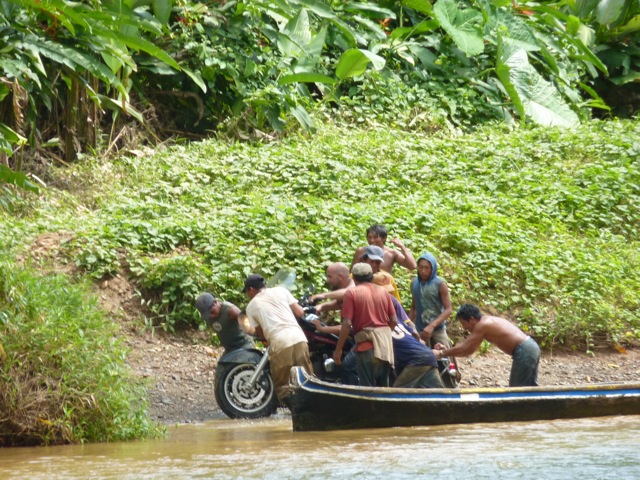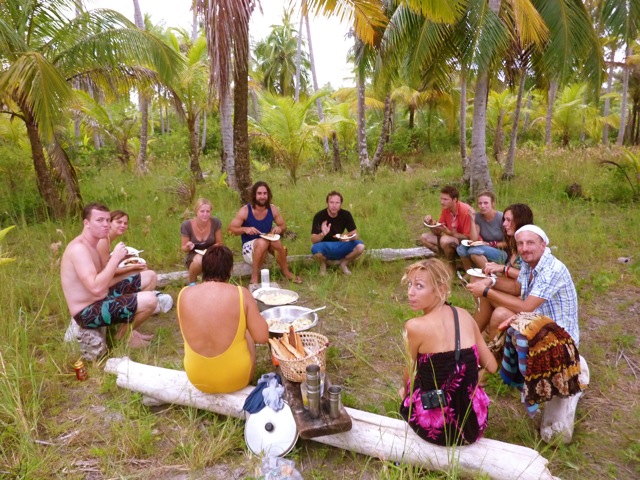The Stahlratte Adventure-Crossing from Panama to Colombia
The Darien Gap, a stretch of dense jungle populated by drug smugglers and growers, paramilitary groups, kidnappers and gun runners prevented any sort of overland travel from Panama to South America, so my choice was either flying the bike at a cost of almost $1,000, plus a ticket for myself, or getting the bike on a boat and sailing for four days via the San Blas islands.I had deliberated over this choice for several days and had decided that sailing would be the best option, and I had picked a boat that a few of my fellow bikers had used before and had a good reputation.
I had been e-mailing the captain of the Stahlratte, a 106 year old fishing boat that was doing the trip from Panama to Colombia, and he had assured me that getting the bike onto the boat was not going to be a problem, all I had to do was to cross a small river, and the rest would be easy.
I knew I was in for quite a tough ride to Carti, where I would pick up the boat, and I was half looking forward to the challenge, and half nervous of dropping the bike and not being able to reach the destination.
At 5am, the Jeeps came to the hostel to pick up passengers, and I put my luggage in the back of one of them. I followed the first Jeep out of town towards Chepo, and then turned off the highway and onto a dirt road. This was a 40km stretch up to the little river that I was going to have to cross.
I followed the Jeep along the road which deteriorated as we went on. The track was made up of vaying types of grave, loose gravel, packed gravel, large rocky gravel, muddy gravel and loose gravel, and in parts, just mud.
I was following the first Jeep up a steep gravel hill when the Jeep stopped. I braked, my front wheel locked, and then the bike started sliding back down the hill. I did all I could to keep the bike upright, but the weight was too much for me and the bike went over.

I jumped off before I got stuck under it and took a deep breath. First things first, take a photo.
I knew I couldnt lift the bike on my own, but I tried anyway.
It was now around 10.30am and the sun was beating down on me. I took my helmet and jacket off, placed them on the side of the road and attempted righting my bike, with no success.
There was nothing to do but wait, and within 10 minutes, the second Jeep appeared at the bottom of the hill, the Jeep I was following had not seen me fall and had continued onwards.
The driver and a few of the passengers form the second Jeep got out and helped me lift the bike, I jumped on, and with a push from the guys, and help from the engine, the bike slowly started climbing the hill, I throttled back gently and the bike stabilized and I picked up speed as I tackled the hill.
There were a few more worrying moments when the back end of the bike was fishtailing wildly behind me in the mud sections and skipping friskily on the loose gravel going up the hills, but by keeping the bike pointed in the general direction of the road, braking with the gearbox, and taking good run ups for the next uphill sections, I finally made it to the river.

My heart sank when I saw what lay ahead. This little river was daunting to say the least. The level of the river was much higher than I had been led to believe. Huge trucks were crossing regularly, the water coming up to the tops of their wheels. As much as I had wanted to have a go at crossing this obstacle unaided, I figured there was too much at stake. The water level was as high as my saddle, and the current was fairly strong, the last thing I wanted was for the engine to stall and the bike to go over and get carried off by the river!
I got talking to Elissa, a lady who was working with the construction crew who were working on improving the road and building the bridge, and she said she had an idea to help me cross the river.
She got on her walkie-talkie and talked rapidly in Spanish to whoever was on the other end of the airwaves. A few minutes later and I heard a heavy rumble in the distance. A minute or so after that, the solution came into view in the form of a yellow JCB digger. The JCB crossed the river and lined up with the huge metal scoop alongside my bike, we measured up the scoop and the bike and soon came to the conclusion that this option, novel as it was, was not going to be the solution after all.

Next, I stopped a bunch of the trucks coming and going across the river to see if any of the drivers would agree to take my bike in the back of their trucks, but with no joy.
Then Julie, the boss of the Jeep drivers, came back from the other side of the river after dropping off the rest of the passengers, and told me more bad news. The boat that the captain was going to send to pick up the bike was not going to be able to come down the river as there were sections of the river that were too shallow for the boat to make it down.
I had had one last option, the Kuna.
The Kuna Indians were a fiercely independent indigenous group who inhabited the islands along the Panamanian coast. They had resisted the pull of modern, city life and still lived traditional lives on their island communities. There was a group of 8 or 9 Kuna men at the banks of the river, and after a little haggling, gesticulating and laughing, they agreed to lift the Harley into one of their canoes and walk it across the river to the other side.
Gingerly, I rode the bike down the mud banks and in to the river until it was alongside the canoe that was barely as wide as the bike.
With a few grunts and plenty of huffing and puffing, together we managed to lift the rear of the bike onto the canoe, and then hefted the front end in too. We pulled the canoe across the river, not helped by another truck that crossed in the opposite direction causing a huge wash that nearly knocked the canoe over, but a few minutes later, we were on the other side, repeating the whole lifting process to get the bike back off the canoe.




The task completed, the river crossed, and I was full of a sense of enormous accomplishment. I thanked the Kuna and paid them their $30, they were overjoyed at the prospect of spending it all on beer and having a party!
I got back on the bike on the other side, slid up the muddy bank and continued along the dirt track to the next river where I would take another boat to the Stahlratte.

I rode the last few remaining kilometers to the final river without any mishaps and arrived at the river as the lancha, a big canoe with an outboard engine that was going to take me to the boat.


The Kuna were there to help again, for a fee, and we walked the bike along a wooden plank until the front wheel was in the boat, then lifted the back end in. It was much harder getting the bike in this larger boat, and in the process, the bike sustained a couple of minor injuries, and I had aching muscles for the next couple of days.


Once the bike was safely wedged into the lancha, we set off along the river to where the Stahlratte was moored. We pulled alongside the ship and one of the crew, a tall blond German guy called Roly,also known as "Tachicumba"-the big man- tied ropes around the bike and we began the winching process.

The bike was lifted onto the deck and strapped up against the side of the deck. We then unloaded the rest of my luggage and I was shown around the boat, before getting in the dingy to go ashore on one of the inhabited Kuna islands.



I walked around exploring the tiny island, crammed with small traditional wooden huts, and traditionally dressed Kuna strolling around. The Kuna are amazing people. In their language, there are no words for work, money or time.
If, for any reason, they need to know what time it is , they will ask you Watchie watchie?, the word that they use for work is the German word, and the word they use for money is the English word. Their culture is one of trade and co-operation. As with many indigenous tribes, you have to ask to take a photo, and normally charged a dollar. I encountered a group of women making the traditional clothes with symbols embroidered on to ward off evil spirits and was invited to join them. We sat and chatted and they explained which animals kept which evil sprits away, and I was allowed to take pictures. Another group of women were sat outside the local store, and were not at all into the idea of me talking with them or taking pictures, even for money.


The crew cooked up a beautiful dinner, and just as the light was fading, the other bikers, who had left a few hours after me, turned up.
Their boats were winched on board and we all sat down over dinner and talked about our day. They all said that when they saw the Harley sat up on the deck as they approached the ship that they were amazed that I had made it.
We were all pretty exhausted, and after dinner I went down to my bunk to sort out some bits and pieces and fell fast asleep, waking up some 10 hours later.
I sat up in the bunk, banged my head on the bunk above me, and stood up. Every muscle in my body was aching. The previous day had been extreme! The riding alone had been physically demanding, and all the lifting off and on boats had left me with a sore back and stiff arms and legs.
At around 11am,the rest of the passenger turned up and our small group of 4 swelled to the full compliment of 18 passengers and 4 crew.
We introduced each other, had a quick orientation of the ship and then we were underway. We sailed for a couple of hours, anchored beside an uninhabited island, donned our snorkel gear and jumped off the boat.



